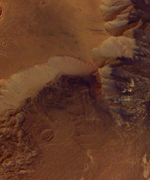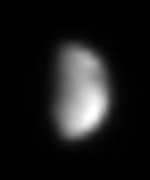The Nearby Supernova Factory, an international collaboration of astronomers and astrophysicists, has announced that SNIFS, the Supernova Integral Field Spectrograph, achieved “first light” during the early morning hours of Tuesday, June 8, when the new instrument acquired its first astronomical target, a Type Ia supernova designated SN 2004ca. Type Ia supernovae are the kind used by astronomers to measure the expansion of the universe.
Analysis of the initial data, plus a separate observation of the newly discovered supernova SN 2004cr on Sunday, June 20th, confirm that SNIFS ? while still in its commissioning phase ? is meeting its design goals as a remarkable new tool for observing supernovae.
SNIFS, which was recently mounted on the University of Hawaii’s 2.2-meter telescope atop Mauna Kea on the island of Hawaii, is an innovative instrument designed to track down the idiosyncrasies and precise distances of Type Ia supernovae by simultaneously obtaining over 200 spectra of each target, its home galaxy, and the nearby night sky.
SNIFS is a crucial element in the international Nearby Supernova Factory (SNfactory), initiated at the Department of Energy’s Lawrence Berkeley National Laboratory. The SNfactory’s goal is to find and study over 300 nearby Type Ia supernovae in order to reduce uncertainties about these foremost astronomical “standard candles,” whose measurement led to the discovery that the expansion rate of the universe is increasing.
“Better knowledge of these extraordinarily bright and remarkably uniform objects will make them even better tools for measuring the cosmos,” says astronomer Greg Aldering of Berkeley Lab’s Physics Division, who leads the SNfactory collaboration. “Type Ia supernovae are the key to understanding the mysterious dark energy that’s causing the universe to expand ever faster.”
The body of the SNIFS instrument was built by the SNfactory’s French collaborators, members of the Laboratoire de Physique Nucl?aire et de Haute Energies (LPNHE) in Paris, the Centre de Recherche Astronomique de Lyon (CRAL), and the Institut de Physique Nucl?aire de Lyon (INPL), supported by the Institut National de Physique Nucl?aire et de Physique des Particules (CNRS/IN2P3) and the Institut National des Sciences de l’Univers (CNRS/INSU). Berkeley Lab, with help from Yale University, developed the cameras used to detect the light from SNIFS, while the University of Chicago developed instruments to monitor the performance of SNIFS.
The SNIFS instrument produces a spectrum at each position within a six- by six-arc-second region around the target supernova, including its home galaxy and surrounding sky, by using an “integral field unit” consisting of an array of individual lenslets. Light is extracted from the telescope’s field of view by a small prism and directed to either blue-sensitive or red-sensitive, eight-megapixel, astronomical CCD cameras. Together these cameras collect all the optical light from each supernova.
A separate photometry camera, running in parallel with the spectrograph under identical observing conditions, allows spectra to be corrected for variables like thin cloud cover. A guide camera keeps the spectrograph precisely aligned on target by measuring the position of a guide star within the telescope’s wider field of view once each second, adjusting the aim if necessary.
Flown to Hilo in March and assembled in working order at sea level, SNIFS was taken apart, carried to the 4,245-meter (nearly 14,000-foot) summit of Mauna Kea, and reassembled on the University of Hawaii’s 2.2-meter telescope on April 6.
“At sea level we made sure everything was in order and also rehearsed the assembly,” says Aldering. “When you get to 14,000 feet things get tricky. Everybody carries a ‘dumb list’ so they don’t start off to do something and then forget what it was.”
Two months of engineering to align and calibrate the instrument on the telescope preceded SNIFS observation of its first new Type Ia supernova, SN 2004ca, on June 8th, in the constellation Cygnus, the swan. This was followed by the observation of SN 2004cr in the constellation Cepheus, the king, on June 20th. Shortly routine observations of SNfactory-discovered supernovae will begin.
“Now that SNIFS is in regular operation,” Aldering says, “our daily lives have changed dramatically.” After years of planning and long-distance meetings, including monthly videoconferences, “the activity level has escalated ? every day we have to react instantly as our new supernova data come pouring in.”
A full schedule ahead
The SNfactory strategy has two “pipelines,” the first being a supernova search using automated wide-field sky surveys. Data are provided by the QUEST-II 160-megapixel camera, built by Yale University and Indiana University and operated at Palomar Observatory by the QUEST-II group, as well as by the Jet Propulsion Laboratory’s Near Earth Asteroid Tracking team and the California Institute of Technology. The data are transmitted by the High-Performance Research and Education Network to the National Energy Research Scientific Computing Center (NERSC) at Berkeley Lab for identification of likely supernova candidates.
The ideal candidate is a recently exploded Type Ia supernova that is near enough for accurate measurement of its spectrum and light curve (its rising and falling brightness) but far enough away to be “in the smooth Hubble flow” ? meaning that its redshift is mostly due to the expansion of the universe alone, unaffected by the motion of its home galaxy through space.
The SNfactory’s search phase has been operating for over a year, although not at full capacity. “The search will now be going full steam,” Aldering says. “We’ll be getting a few candidates each night of the year ? more than the entire current worldwide rate of discovery.”
SNIFS is mounted on the University of Hawaii’s 2.2-meter telescope atop Mauna Kea on the island of Hawaii.
The second SNfactory pipeline passes the search candidates on to SNIFS, where the type and redshift of each supernova are determined and the most promising are selected and scheduled for more detailed study. The SNfactory uses the University of Hawaii’s telescope three times a week for half a night ? the half beginning at midnight, as a courtesy to local observers ? with SNIFS available to other projects at other times.
Eventually SNIFS will operate fully automatically. Remote control of the telescope and spectrograph was first done from Hilo, Hawaii and is now being done from Berkeley Lab and France.
SNIFS can determine a given Type Ia’s specific physical characteristics including, for example, whether or not it is unusually energetic or how much its light may have been dimmed by dust in its home galaxy. Such unparalleled spectrographic and photometric detail makes it possible to take advantage of a unique characteristic of Type Ia supernovae: that “they can be calibrated individually, not simply statistically,” Aldering says. “We’ll be able to measure the luminosity with confidence. Knowing the luminosity, we can tell you the distance with precision.”
By collecting large numbers of Type Ia supernovae in the Hubble flow, SNfactory scientists will be able to pin down the low-redshift end of the luminosity-redshift diagram upon which measures of the universe’s expansion rate are based. This, plus detailed understanding of the physical factors that cause small variations in Type Ia spectra and light curves, will improve the accuracy of the high-redshift measurements crucial to choosing among the many competing theoretical models of dark energy.
Members of the Nearby Supernova Factory team include Greg Aldering, Peter Nugent, Saul Perlmutter, Lifan Wang, Brian C. Lee, Rollin Thomas, Richard Scalzo, Michael Wood-Vasey, Stewart Loken, and James Siegrist from Berkeley Lab; Jean-Pierre Lemonnier, Arlette Pecontal, Emmanuel Pecontal, Christophe Bonnaud, Lionel Capoani, Dominique Dubet, Francois Heunault, and Blandine Lantz from CRAL; Gerard Smadja, Emmanuel Gangler, Yannick Copin, Sebastien Bongard, and Alain Castera from INPL; Reynald Pain, Pierre Antilogus, Pierre Astier, Etienne Barrelet, Gabriele Garavini, Sebastien Gilles, Luz-Angela Guevara, Didier Imbault, Claire Juramy, and Daniel Vincent from LPNHE; and Rick Kessler and Ben Dilday from the University of Chicago. Recently the astrophysics group at Yale University, under the leadership of Charles Baltay, has joined the Nearby Supernova Factory.
The Berkeley Lab is a U.S. Department of Energy national laboratory located in Berkeley, California. It conducts unclassified scientific research and is managed by the University of California. Visit our website at http://www.lbl.gov.
Original Source: Berkeley Lab News Release


